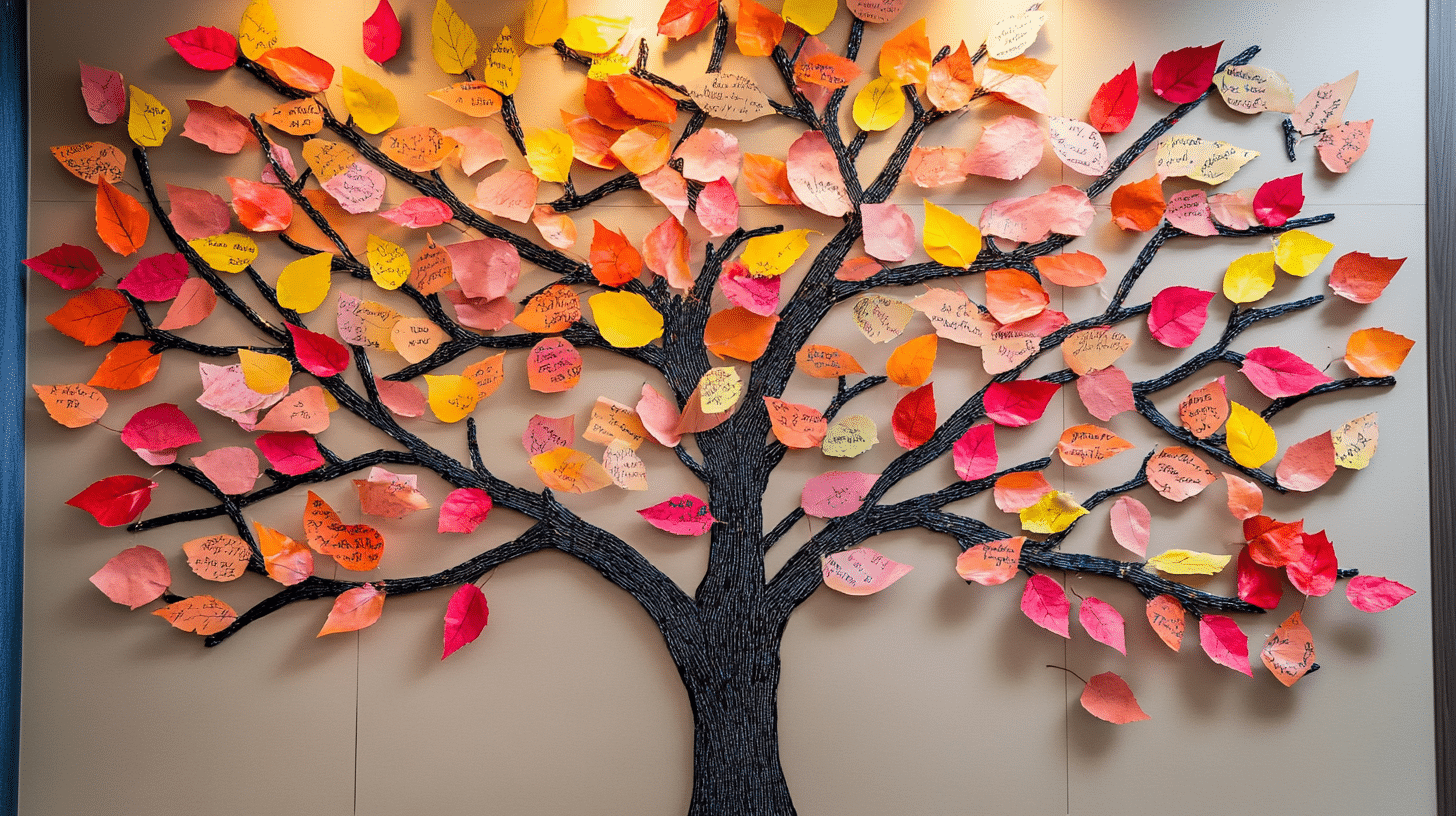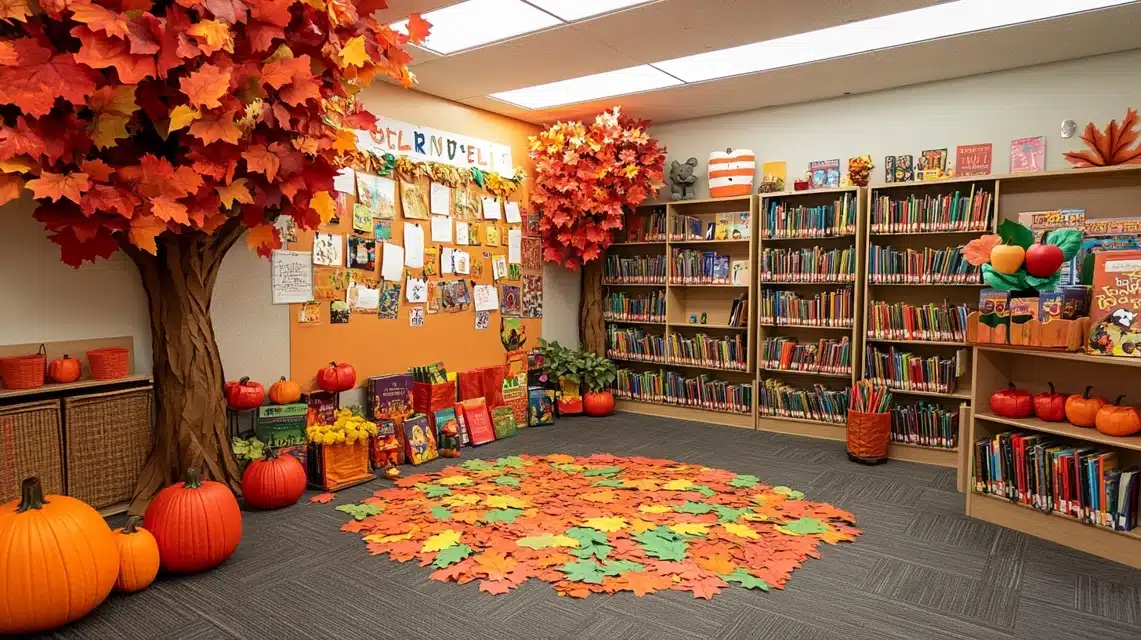Imagine walking into a library that feels like a warm autumn afternoon, where every fall library bulletin board tells a story and invites curiosity. Bulletin boards are more than decorative walls; they’re powerful tools for engaging students, showcasing books, and building a reading community.
School libraries often struggle to capture students’ attention in the digital age, but fall offers a golden opportunity to create magnetic, interactive spaces that draw readers in.
This blog will cover some creative fall library bulletin board ideas that will change your library from a quiet space into an exciting hub of learning and imagination.
Get ready to turn pages and spark excitement with displays that students can’t resist learning.
Importance of Fall Library Bulletin Board
Fall is a great time to refresh your library displays. Bulletin boards brighten the space, share helpful messages, and bring the school community together with seasonal colors and fun ideas.
Make the Library a Seasonal Hub
Fall gives you a chance to make your library the center of school life. Students feel welcome when they see autumn colors and themes as they walk in.
Create displays that celebrate harvest time, show gratitude, and highlight the beauty of changing leaves.
Adding books that match these themes helps students connect reading with the world around them.
A simple arrangement of fall colors alongside book covers creates a warm, inviting space where students want to spend time.
Boost Student Engagement
Fall bulletin boards naturally catch students’ attention with their warm colors and familiar themes. Use this interest to start conversations about books and reading habits.
Place autumn-themed book recommendations where students will notice them during their library visits. Make your displays interactive by adding elements students can touch or change.
A “Fall Reading Tree” where students add leaf cutouts after finishing books or a “Guess the Autumn Story” feature with hidden clues keeps them coming back to see what’s new.
These simple additions make the library a more active, exciting place to visit.
Reinforce Library Lessons Creatively
Use fall themes to teach important library skills in ways students will remember.
A bulletin board showing how to “harvest good information” can teach research basics using visual cues students understand. Different colored leaves can represent types of sources or steps in the research process.
Connect your displays to what students are learning in class. For example, if they’re studying plant life cycles, create a board about how trees prepare for winter. If they’re reading certain authors, feature those books with fall decorations.
These connections help students see how the library supports their learning all year round.
Ideas for Fall Library Bulletin Boards
There are plenty of creative ways to decorate your library for fall. From cozy themes to interactive displays, these ideas will make your library feel warm, inviting, and exciting.
1. Harvest of Good Reading

Create a farmstand display with book covers as “crops.” Use baskets filled with autumn-colored bookmarks listing fall titles.
Add paper pumpkins with genre labels and apples featuring author names. This bright, warm display draws students in while highlighting seasonal stories they might otherwise miss.
2. Gratitude Wall

Set up a tree trunk with empty branches and a basket of leaf-shaped sticky notes nearby. Students write what they’re thankful for and add leaves to the tree.
Watch the bare branches fill with colorful thoughts throughout the season. This builds community while creating a beautiful, meaningful display.
3. Book Recommendation Tree

With this peer-driven display, students become the experts. Create a large tree and provide leaf-shaped papers on which students can write book titles they love.
Organize leaves by genre or reading level using different colors. This student-led approach often introduces unexpected titles that librarians might not think to feature.
4. Cozy Reads for Chilly Days

Craft a window scene with paper flames, a comfy chair, and falling leaves outside. Feature books perfect for snuggling up with when the weather turns cold.
Add a basket of simple bookmark takeaways so students remember their selections. This display’s visual warmth naturally draws students.
5. Digital Citizenship in the Fall

Change online safety lessons into seasonal visuals. Create a “Digital Safety Scarecrow” with tips on protecting personal information.
Or design a tree where good online habits are “ripe apples” and poor choices are “fallen fruit”. This approach makes abstract concepts more concrete and memorable.
6. Fall Into a Good Book

Create a pile of autumn leaves cut from construction paper, with each leaf featuring a book cover or title. The “leaf pile” can spill across the board or down onto a table with the actual books.
The wordplay and vibrant colors grab attention and make browsing fun.
7. Pumpkin Patch of Stories

Cut orange pumpkin shapes and let students write brief book reviews on them. Arrange these in a “patch” with green vines connecting them. Add “prize pumpkins,” featuring librarian picks.
This gives students ownership of the library space while promoting peer recommendations.
8. Falling for New Authors

Introduce writers students might not know with this themed board. Create falling leaves, each featuring an author’s photo and quick facts. Below each leaf, display one of their books.
Focus on new voices or writers from diverse backgrounds to expand students’ reading horizons.
9. Acorn Achievements

Celebrate reading milestones with this growth-focused display. Students earn paper acorns when they finish books, try new genres, or complete challenges.
Over the season, these acorns grow into mighty paper oaks. This visual tracking system motivates readers to keep going.
10. Scare Up Some Good Reads

Design a friendly scarecrow surrounded by book covers as “crows.” Add speech bubbles with the scarecrow recommending titles like “This one gave me goosebumps!” or “I couldn’t put this down!”
The playful approach makes book selection less intimidating for reluctant readers.
11. Sweater Weather Stories

Create a clothesline with paper sweaters, each featuring a book title perfect for cozy fall reading. Include diverse genres all sharing warm, inviting themes.
Students can take a “sweater”
recommendation slip to help them find the book. The familiar fall imagery makes the book selection approachable.
12. Bonfire Book Club

Build a paper “bonfire” with book spines as logs. Surround it with paper marshmallows featuring reading prompts or discussion questions.
This creates a conversation-starting display that promotes thoughtful reading. Include seating nearby to encourage students to gather and talk about books.
13. Autumn Poetry Corner

Showcase student-written fall poems alongside famous autumn verses. Print poems on leaf shapes in fall colors. Include blank leaves for students to add their creations.
This connects students’ creativity with established literary traditions while creating a constantly evolving, collaborative display.
14. Spooky Stories for Fall

Feature age-appropriate eerie tales on a board with a haunted house background. Group books by “slightly spooky,” “moderately mysterious,” and “truly terrifying” to help students find their comfort level.
This themed collection meets high student interest while introducing classic and contemporary titles.
15. Cornucopia of Knowledge

Create a large horn of plenty spilling out interesting facts and book recommendations across different subjects. Include QR codes linking to additional resources.
This cross-curricular approach shows how the library supports all areas of learning while using seasonal imagery students recognize.
16. Apple-Picking Book List

Make a paper apple tree, with each fruit featuring a librarian or teacher book recommendation. Students “pick” paper apples with titles that interest them.
Include fiction and non-fiction options at various reading levels. The interactive element makes choosing books more engaging and fun.
17. Migration Reads

Create a V-formation of flying birds, each carrying a book title about journeys, transitions, or natural changes. Below, display the actual books.
This theme connects fall’s natural patterns with stories of movement and change that resonate with students in times of change.
18. Rake in the Reads

Design a playful scene with a paper rake gathering book covers instead of leaves. Group books by theme or reading level in different “piles.”
This visual play on words creates an eye-catching display that makes finding new books feel like a seasonal treasure hunt.
19. Hayrides & History

Craft a hay wagon filled with non-fiction books about fall traditions from various cultures. Include harvest festivals, seasonal crafts, and agricultural history.
This display expands students’ cultural awareness while highlighting informational texts that might otherwise be overlooked during fiction-heavy reading seasons.
20. Fall Favorites Poll Board

Set up a voting station where students place leaf stickers next to their favorite fall books. Categories might include “Best Spooky Tale” or “Coziest Read.” Tally and display results weekly.
This creates community engagement while generating valuable data about student reading preferences.
21. Sporty Library Bulletin Board

Combine school spirit and fall reading with team colors and mascots promoting books. Create a football field display where books “score touchdowns” or a paper track where books “run races.”
This connects library activities with other school interests, drawing in diverse student groups.
22. Mystery in the Leaves

Hide mystery book covers behind large paper leaves. Students lift the leaves to reveal potential reads. Include clues or the first line of each book to spark interest.
This interactive element adds surprise to the book selection while highlighting an always-popular genre.
23. Woodland Creatures’ Reading Nook

Create forest animal holding book recommendations. Owls can suggest knowledge-building titles, foxes can recommend clever mysteries, and rabbits can highlight quick reads.
This approach adds character to suggestions while subtly categorizing books in a way that young readers easily understand and remember.
24. Read, Reflect, Repeat

Design a mirrored lake with paper leaves floating on its surface. Each leaf contains a reflection question about the recent reading. Students can add their questions, too.
This thoughtful approach encourages deeper engagement with texts while creating a calm, contemplative area within the library.
25. Seasonal STEM Spot

Highlight science and nature books explaining fall phenomena like leaf color changes, animal preparation for winter, and harvest science.
Add simple experiment instructions students can try at home. This connection between seasonal observation and STEM learning makes science more relevant and accessible.
Tips for Creating Fall Library Bulletin Boards
Making your fall bulletin boards doesn’t have to be hard. With a few smart tips, you can create displays that are easy to set up and fun for students.
Keep It Low-Prep but Impactful
Make eye-catching bulletin boards with easy, time-saving ideas.
- Save time with ready-made printable templates for fall shapes and letters
- Use die-cuts if available at your school
- Cut several leaf shapes at once by stacking paper
- Pre-made borders in autumn colors create instant seasonal frames
- Choose one focal point rather than many small elements
- Consider reusable items like fabric leaves that store flat for next year
Get Students Involved
Let students help with displays to build excitement and ownership.
- Assign student helpers to cut shapes or arrange items during library visits.
- Create “add-on” boards where students contribute book reviews on leaf shape.
- Set up student voting areas for favorite fall reads using stickers
- Have classes compete to fill sections with reading achievements
- This involvement builds ownership while reducing your workload
- Makes displays of meaningful community projects
Incorporate Seasonal Colors and Textures
Mix oranges, reds, browns, and yellows for a genuine fall feeling. Layer different paper textures for visual interest. Add natural elements like real pressed leaves (laminated for durability).
Use burlap as an earthy background material. Create dimension with 3D elements—curl paper edges, add tissue paper pumpkins.
These simple touches make boards stand out from flat classroom walls.
Refresh Boards Monthly
Plan three fall rotations: September (back-to-school/early autumn), October (Halloween/harvest), and November (gratitude/late fall).
Keep the base elements but swap featured books and interactive components. Take photos before dismantling for next year’s reference.
Prepare materials for the next board while the current one is displayed. This approach maintains student interest while effectively managing your preparation time.
Wrapping Up
Creating engaging fall library bulletin boards is more than just decoration as it is about sparking curiosity and connecting students with reading.
Start small, involve your students, and don’t be afraid to experiment. These displays are your secret weapon to change the library into a vibrant, welcoming space that students will love.
Remember, the most powerful bulletin boards tell a story, invite interaction, and make reading feel exciting and accessible to everyone.
So, start making your own fall library bulletin board today, and be sure to show us how they turn out in the comments below!




